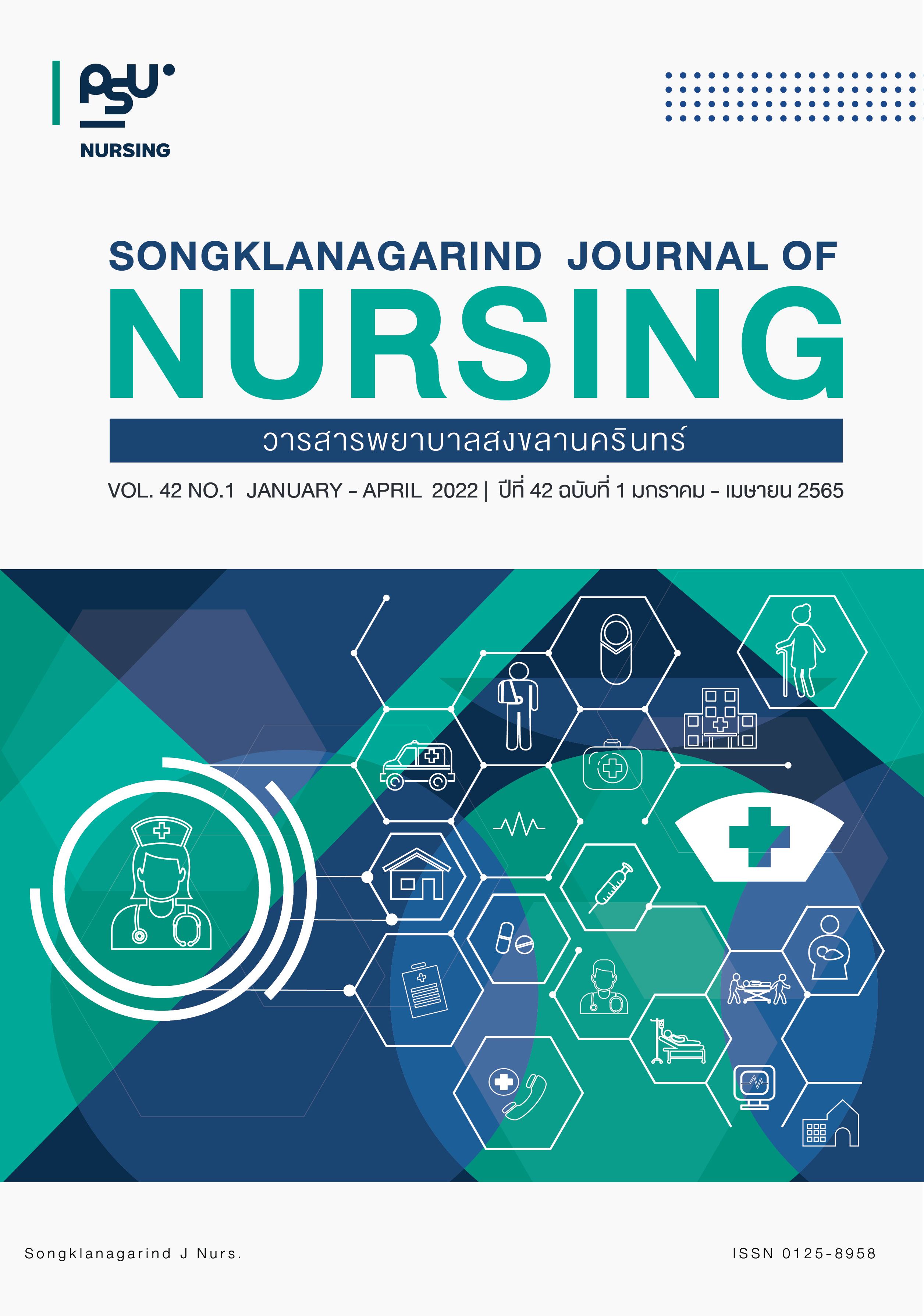ความหมายความปลอดภัยของผู้ป่วยผ่านการแสดงออกทางสุนทรียะ ของนักศึกษา คณะพยาบาลศาสตร์ มหาวิทยาลัยสงขลานครินทร์
Main Article Content
บทคัดย่อ
วัตถุประสงค์: ความปลอดภัยของผู้ป่วยเป็นหัวใจสำคัญของเป้าหมายของการให้บริการสุขภาพ งานวิจัยเชิงคุณภาพนี้มีวัตถุประสงค์เพื่อศึกษาการให้ความหมายของความปลอดภัยของผู้ป่วยตามความเข้าใจของนักศึกษาพยาบาลเกี่ยวกับความปลอดภัยของผู้ป่วยผ่านการแสดงออกทางสุนทรียะ (วาดภาพ) วิธีการวิจัย: ผู้ให้ข้อมูลเป็นนักศึกษาพยาบาล ชั้นปีที่ 3 คณะพยาบาลศาสตร์ มหาวิทยาลัยสงขลานครินทร์ จำนวน 30 คน เครื่องมือที่ใช้ในการวิจัย คือ 1) แนวทางการวาดภาพ และ 2) แนวคำถามการสัมภาษณ์เกี่ยวกับการให้ความหมายภาพที่วาดกับความปลอดภัยของผู้ป่วย เก็บรวบรวมข้อมูลโดยให้ผู้ให้ข้อมูลวาดภาพ พร้อมเขียนคำอธิบายใต้ภาพและการสัมภาษณ์ ผลการศึกษา: โดยการวิเคราะห์เนื้อหา ผลการศึกษาพบว่า ผู้ให้ข้อมูลให้ความหมายของความปลอดภัยของผู้ป่วย 4 ประเด็น คือ 1) ความปลอดภัยของผู้ป่วยเป็นจิตสำนึกและความตั้งใจของพยาบาลในการระวังอันตรายที่อาจเกิดขึ้น 2) ความปลอดภัยของผู้ป่วยเป็นการปฏิบัติตามมาตรฐานการพยาบาล 3) การดูแลความปลอดภัยของผู้ป่วยต้องคิดว่าผู้ป่วยเป็นสมาชิกในครอบครัว และ 4) ความปลอดภัยของผู้ป่วยเกิดจากความร่วมมือของทุกคน สรุป: ผลการศึกษานี้สามารถเป็นแนวทางให้อาจารย์พยาบาลนำไปใช้ในการพัฒนาการเรียนการสอนเพื่อให้นักศึกษาได้รับประสบการณ์เกี่ยวกับความปลอดภัยของผู้ป่วยที่หลากหลาย เพื่อช่วยให้นักศึกษาได้บ่มเพาะค่านิยมความปลอดภัยของผู้ป่วยอันเป็นพื้นฐานสำคัญของการสร้างวัฒนธรรมความปลอดภัยในวิชาชีพการพยาบาล
Article Details

อนุญาตภายใต้เงื่อนไข Creative Commons Attribution-NonCommercial-NoDerivatives 4.0 International License.
เอกสารอ้างอิง
The Healthcare Accreditation Institute (Public Organization). Patient safety goal: SIMPLE Thailand 2018. Nontaburee: Famous and successful; 2018. Thai.
Thiangchanya P. Patient safety management for nurse administrators. Songkhla: Chanmuang Press; 2022. Thai.
World Health Organization. Patient safety curriculum guides multi-professional edition [Internet]. Geneva: WHO press; 2011 [cited 2018 Jan 9]. Available from: http://apps.who.int/iris/bitstream/10665/44641/1/9789241501958_eng.pdf.
Mansour M. Current assessment of patient safety education. Br J Nurs. 2012; 21(9): 536-43. doi: 10.12968/bjon.2012.21.9.536.
Carper BA. Fundamental patterns of knowing in nursing. ANS Adv Nurs Sci. 1978; 1(1): 13-23. doi: 10.1097/00012272-197810000-00004.
Chinn PL, Maeve MK, Bostick C. Aesthetic inquiry and the art of nursing. Sch Inq Nurs Pract. 1997; 11(2): 83-96.
Khumpho P, Chintanadilok N, Payakkaraung S, et al. Painrelieving effect of music therapy on school age children having received bone marrow aspiration. JTNMC. 2014; 29(1): 82-94. Thai.
Perkins A. Music and art therapy: Approaching patient care with a different stroke. Nursing made Incredibly Easy! May [Internet]. 2020 [cited 2021 Feb 15].Available from: https://journals.lww.com/nursingmadeincrediblyeasy/fulltext/2020/05000/music_and_art_therapy_approaching_patient_care.5.aspx
Literat L. “A pencil for your thoughts”: Participatory drawing as a visual research method with children and youth. IJQM. 2013; 12: 84-98. doi: https://doi.org/10.1177/160940691301200143.
Sandoval BS. Photovoice an exercise of emancipation for nursing. Am. J. Nurs. Res. 2017; 3(1): 1-4.
Moorman M, Hensel D. Using visual thinking strategies in nursing education. Nurse Educ. 2016; 41(5): 5-6. doi: 10.1097/NNE.0000000000000185.
Dolatabadi F, Ziaeirad M. The relationship between critical thinking and patient safety culture in the nurses. [Abstract]. JNE. 2021; 10(2): 1-12.
Chan ZC. Drawing in nursing PBL. Nurse Educ Today. 2013; 33(8): 818-22. doi: 10.1016/j.nedt.2012.02.018.
Blomqvist L, Pitkälä K, Routasalo P. Images of loneliness: Using art as an educational method in professional training. [Abstract]. J Contin Educ Nurs. 2021; 38(2): 89-93. doi: https://doi.org/10.3928/00220124-20070301-05.
Schwind JK, Lindsay GM. Arts-informed narrative inquiry as a practice development methodology in mental health. IPDJ. 2015; 5(1): 1-12. doi: https://doi.org/10.19043/ipdj.51.005.
Kongsuwan W, Apichato A, Maneewat K. Carin as nursing: Aesthetic expression of nursing students. Songklanagarind J
Nurs. 2018; 41(2): 1-12. Thai.
Matchim Y, Thongthawee B, Nirattharadorn M, et al. Experiences of learning in the course of development of nursing profession and nursing science: esthetic expression of first-year nursing students. Songklanagarind J Nurs. 2021; 41(2): 1-10. Thai.
Thongkaew S, Thongsuk P, Thiangchanya P. Patient safety awareness among novice nurses working in general hospitals in Southern Thailand. SCNJ. 2018; 5(1): 62-73. Thai.
Juliato R. Thaingchanya P. Boonyoung N. Nurses’ patient safety competencies in Aceh Province, Indonesia. Nurse Media J. Nurs. 2014; 4(1): 659-70. doi: 10.14710/nmjn.v4i1.6704.
Husserl E. The phenomenology of internal timeconsciousness. 2 nd ed [Internet]. Bloomington: Indiana University Press; 2019 [cited 2020 Dec 15]. Available from: shorturl.at/crRS6
Shies HF, Shanon SE. Three approaches to content analysis content analysis. Qual Health Res. 2005; 15: 2077-88. doi: 10.1177/1049732305276687.
Lincoln YS, Guba EG. Naturalistic inquiry. Beverly Hills, CA: SAGE; 1985.
Kim L, Lyder CH, Mcnees-Smith D, et al. Defining attribute of patient safety through a concept analysis. J Adv Nurs. 2015; 71(11): 2490-503. doi: 10.11112jan.12715.
Vaismoradi M, Tella S, Logan AP, et al. Nurses’ adherence to patient safety principles: A systematic review. Int. J. Environ. Res. Public Health. 2020; 17(6): 1-15. doi: 10.3390/ijerph17062028.
Thiangchanya P, Peeravud J, Thapattaraporn M, et al. Nurses’ role in enhancing patient engagement in safety. Songklanagarind J Nurs. 2016; 36(3): 247-60. Thai.
Siwawut J, Thiangchanya P, Thongsuk P. Non-technical skills of perioperative nurses for patient safety in tertiary hospital, Thailand. Nursing J. 2020; 47(4): 458-69. Thai.
Bunditlerdrak C, Thiangchanya P, Boonyoung N. Effective collaboration in operating rooms of University Hospitals in Thailand: The 7 Components and 43 Elements of a Structured Practice. SCNJ. 2022; 9(1): 186-98. Thai.
Weatherford HB, Viveiros AJ. Senior nursing students’ perspectives on safety competencies: an end of program outcome evaluation. Nurs Educ Perspect. 2016; 36(3): 182-4. doi: 10.5480/13-1182.


